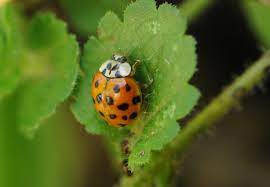By CECELIA SHILLING
ANNAPOLIS, Md. – A spooky, imported ladybug, often mistaken for a native bug, known as the Halloween beetle is preparing to migrate from gardens and into homes as Maryland heads for colder weather.
And while they are extremely valuable to plant life, the little bugs bite. Halloween beetle home infestations could result in odors and stains, too.
When these pumpkin-colored beetles aren’t invading homes, they are outdoors helping control the aphid population by eating as many as 1,000 of the pests during their development, said University of Maryland entomology professor and extension specialist Michael Raupp.
Aphids, often called plant lice, damage host plants by sucking juices from leaves and promoting discoloration, leaf curling and stunted growth in crops like squash, cucumbers, melons, beans and potatoes, said the University of California Agriculture and Natural Resources pest management program.
“These (Halloween beetles) are enormously beneficial,” Raupp said. “They were actually imported at least a couple of times in the United States to help reduce pest populations on important agricultural crops. In the South, they were very important in helping to reduce pests in pecan crops.”
Also called the Asian ladybug, lady beetle or multicolored ladybird beetle, the bug was imported from Asia and released in 1916 to control pests. The first established population in the U.S. was found in New Orleans in 1988. Since their initial release, entomologists transported the insect across the country a number of times, said the U.S. Department of Agriculture.
Unlike the native American common convergent ladybug, the Halloween lady beetle can be identified by an “M” shaped marking behind its head and can be red, yellow or orange with black spots, Raupp said.
“Adults (mature Halloween beetles) often cluster together in October and November to overwinter in sheltered locations. When a few adults find a suitable spot, they release a chemical that attracts other multicolored Asian lady beetles to the same location,” said a Clemson Extension Home and Garden Center fact sheet. They then move together indoors.
Though the insects are good for gardens and plant life, they may become a nuisance when indoors.
When threatened, the insect employs a reaction called ”reflex bleeding” that releases bitter-smelling and tasting chemicals from their joints that are a “nasty witch’s brew of many different compounds that evolved to deter predators,” Raupp said.
“If you pick these things up they’ll leave kind of funny yellow or orange stain on your finger. If you smash them against the drape, they’re going to discolor that drape,” he said. “There are also reports of these little guys giving you a little nip.”
A Halloween beetle bite can leave some people with small, painful bumps on their skin, but their bites aren’t something to worry about. They don’t sting or carry disease, according to the Michigan State University Center for Integrated Plant Systems.
That’s not how University of Maryland student Zainab Balhis remembers a Halloween beetle infestation in October of 2021 in her College Park dorm room.
“When I was living in Centreville (a UMD dorm) during my freshman year, eight in the span of a week flew into my room,” Balhis said. “They were getting in through the cracks in my window because I was living in an older dorm.”
Balhis also remembers one “pretty gnarly bite,” she saw on her skin while the bugs were in her room.
The best way to keep Halloween beetles out of your home is to seal all openings and cracks, Raupp said.
“The best way to manage Asian ladybugs is to prevent them from getting inside the home in the first place,” according to the University of New Hampshire Extension service.
“Remove air conditioners when they are no longer needed and take care to seal up cracks around windows and doors, particularly on the sunny southern and western sides of the house.”




Recent Comments